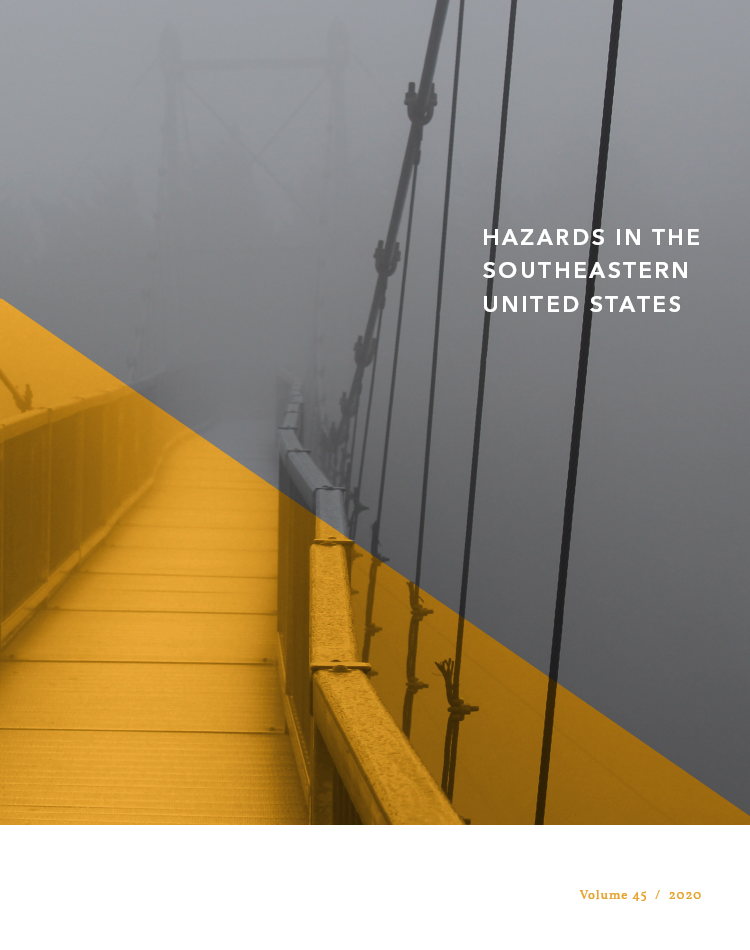
Hazards in the Southeastern United States (2020)
Editor: Natalie Swanson
Volume 45 of the Carolina Planning Journal, titled Hazards in the Southeastern United States, considers how planners can prepare for natural disasters in the near and distant future. The topic is timely given the significant impacts and costs of recent natural hazard events in our backyard following Hurricanes Florence and a devastating 2017 hurricane season.
Environmental scientists and climate change specialists project that instances of million dollar natural disasters will increase over the next decade. As their communities face greater human and financial impacts from climate change and natural disasters, planners are considering how to respond in terms of preparedness, recovery, and long-term resilience. Authors in this volume discuss the challenges and best practices surrounding public participation, collaboration, equitable response, and available tools within the natural disasters context.
This edition begins by exploring existing tools to support adaptation and resilience. Matt Stern, MCRP ‘19, considers the equitability and effectiveness of popular mechanisms to finance climate change adaptation and resilience. Outlining the shortcomings of existing options, he presents a new finance tool that aims to maximize equity and minimize vulnerability. Phil Berke, Jaimie Masterson, AICP, Matthew Malecha, and Siyu Yu, AICP, discuss the application of the Resilience Scorecard as a tool to measure whether mitigation plans are well integrated and actionable. The article turns to the program’s pilot community of Norfolk, Virginia as an example.
Many communities grapple with developing successful recovery and adaptation plans. Christian Kamrath, MCRP ‘18, CFM, and Holly White, AICP, CFM turn to the local case study of Nags Head, North Carolina to evaluate the role of public participation in local adaptation planning utilizing both local and state-initiated processes. Michelle Bohrson, April Geruso, and Kayla Slater offer the case study of private sector collaboration in Panama City. This case similarly identifies public engagement as essential to successful plan development.
Another set of articles also grapple with ideas of public engagement as a tool to build capacity. Laura Bray, Olivia Vilá, Bethany Cutts, Margaret Crites, Hannah Goins, Sallie McLean, Nathan McMenamin, David Lowry, Mac Legerton, and Angela Harris present a case study of public engagement in Robeson County, post-Hurricane Matthew, as a method of increasing community capacity and environmental justice as participants come to better understand personal risks that result from flooding. Shaleen Miller discusses global collaborations between organizations like botanical gardens in the wake of Hurricane Maria as examples of unconventional knowledge sharing.
The final articles consider the vulnerability and equity of response networks. Ryan Scott purports that military bases are vulnerable to sea level rise. Given that they are essential to emergency response during disaster events, he provides recommendations to protect both installations themselves and the people associated with them. Carlee Purdum discusses the exploitative nature of using incarcerated people, receiving insufficient compensation, as a cheap alternative to wildland firefighters.
As always, this volume includes an overview of Master’s Projects from 2019, a year-in-review newsletter from the halls of New East, and book reviews by current students.
The cover image by photographer Joseph Hoffheimer, MCRP ‘20, captures the Mile High Swinging Bridge on Grandfather Mountain in North Carolina. Much like the bridge, this volume offers guidance to help us navigate what can feel like an uncertain, frightening future. The era of climate change presents a plethora of new planning challenges, and these authors remind us not only of the necessity to change but also of our remarkable capacity to adapt.
A digital version of this volume is available here.